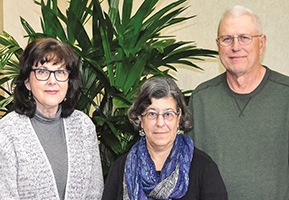How the Other Half Teaches
February 01, 2017
The missed opportunity for classroom paraprofessionals to contribute to students' language learning

Building the capacity of a school district’s instructional staff is supposed to extend the expertise of all adults who work with students — teachers, administrators, support service providers and paraprofessionals. The role of the latter group, commonly known as parapros, has received little attention from education reformers and policymakers, even though an estimated 1.2 million parapros assist with instruction in schools nationwide.
Many of these parapros work at the frontlines of instruction for struggling language learners. When their teaching capacity is ignored, so too are the literacy needs of English language learners and students with individualized education programs. Parapros sit near the bottom of the district food chain, despite their importance to literacy instruction.
Based on a study of paraprofessionals in Ohio that the three of us conducted and a national literature review, parapros typically don’t get full-time work, are often paid minimum wage, receive little to no professional development and are not included as members of instructional teams. Nevertheless, national standards such as those developed by the Council for Exceptional Children and competencies developed by the Ohio Partnership for Excellence in Paraprofessional Preparation now recognize an instructional role for classroom parapros.
Expanding Presence
From the time they were first introduced in public schools in the 1960s, use of paraprofessionals became especially pronounced in low-resource schools, particularly in big cities, where large numbers of students deal with difficult personal challenges. Chronic teacher shortages in these districts were a catalyst to hire individuals with less formal preparation to help manage students. When the student-to-adult ratio grew too high, parapros sometimes filled the gaps in the neediest classrooms. Some advocacy groups, especially those in special education, began to raise questions about the instructional capacity of these educators.
The most motivated parapros use this as a starting point on the career ladder in education. They complete the necessary coursework for teaching degrees and credentials. Cultivating this aspiration makes sense for meeting particular instructional needs of a diversifying student population. Who doesn’t have a need for bilingual educators who can support English language learners?
In one Ohio district, an instructional team supervised several parapros who accompanied students to general education classrooms. In those classrooms, each provided one-on-one or small-group support to assist ELLs in interpreting and completing assignments. This worked well because both the student and the parapro shared fluency in a language other than English.
Problems Identified
Teachers often lack expertise in working with the parapros assigned to them. According to 70 percent of respondents to our Ohio study of how school districts use parapros, classroom teachers are “only occasionally” well-prepared to supervise parapros. And yet, many of these least-valued and least-prepared educators regularly provide the most substantive instruction to the students with the steepest learning challenges — English language learners and students in special education (among whom ELLs are over-represented).
Through the Ohio Partnership for Excellence in Paraprofessional Preparation, however, teachers across Ohio’s 16 State Support Team regions have begun working together in online professional development to establish more effective practices for supervising parapros. And the parapros are receiving training to realize their potential as instructional helpers.
The Wooster, Ohio, City School District is aligning its professional development for parapros with its districtwide literacy initiative. The district’s parapros themselves have played a role in identifying the training they need, and the Ohio partnership is integrating content that will support parapros who help with early literacy instruction as well as assisting with classroom management. Like Wooster, the 4,000-student Teays Valley Local School District in Ashville, Ohio, is focusing on the role parapros play in strengthening instruction in early literacy.
In the Cuyahoga Falls City School District in northeastern Ohio, paraprofessionals focus on effective communication. In the Gahanna-Jefferson Public Schools in central Ohio, the training is on instructional support — building instructional support skills such as using graphic organizers to scaffold instruction for struggling learners and using explicit directions with students, including English language learners, who have trouble making inferences.

Better Uses
What might school districts do to better use their paraprofessionals?
First, define the relationship between helping with teaching and actually teaching. Teachers take responsibility for designing instruction, overseeing the lesson delivery and assessing instruction. Parapros help deliver instruction and administer assessments to individuals and small groups of students under teacher direction. School leaders must recognize the difference and clearly define the roles in ways that fit with district needs.
Second, use a team approach when assigning parapros. The administrative team responsible for parapros should be durable. Why? The team will need to understand what’s possible in a particular district, confront ongoing challenges as they apply the role definitions and understand that changing circumstances will demand some flexibility. Attention by site leadership can have a huge payoff.
Third, address the predictable issues administrators will confront wherever paraprofessionals are employed in schools. The most common relate to these steps:
- Determine hiring priorities (hours, benefits, qualifications, wage differentials). It makes sense to start improvements in this realm incrementally. Health insurance, of course, would be appealing to low-wage employees.
- Prepare teachers to supervise parapros. Supervision is not something every teacher can do, so don’t expect it. Find those who can provide support and train them and the parapros jointly.
- Prioritize the types of roles paraprofessionals will fill. How will the district concentrate or disperse the services of parapros? Will it primarily be one-on-one assignment to individual students or to a classroom (general education, special education or both)? What special considerations will support English language learners?
- Address students with low-incidence sensory disabilities. Visual and/or hearing impairments impose critical literacy considerations, yet needs for literacy support among these students typically are overlooked.
- Require professional development for parapros. In Ohio, 42 percent of school districts in our study did this on their own. Typically, they use one-shot workshops. Careful planning can connect parapro training to ongoing district literacy initiatives and support for ELLs and other students with special needs.
- Design formative evaluation for teacher-parapro teams. Unrelated to employment decisions, formative evaluation should connect closely to the definition of the parapro role and the district’s expectations for teachers who supervise parapros.
Untapped Potential
That’s plenty to start with for a role that has been largely institutionalized and neglected. The big takeaway is to treat the district’s paraprofessionals as significant players. They have the potential, as an entire cadre, to connect the school to the community, to provide instructional support in inclusive classrooms and to increase the number of caring adults with whom students interact.
Additional Resources
The authors consider these among the most practical, recent informational resources on the subject of paraprofessionals in K-12 education.» “CEC Paraeducator Professional Development Standards,” Council for Exceptional Children. www.cec.sped.org/Standards/Paraeducator-Preparation-Guidelines
» “Critical Issues Brief: Concerns about the Proliferation of One-to-One Paraprofessionals” by Michael F. Giangreco, Council for Exceptional Children, Division on Autism and Developmental Disabilities. http://files.eric.ed.gov/fulltext/ED543012.pdf
» Four learning modules for paraprofessionals (“Helping With Instruction,” “Communication and Collaboration,” “Helping Students Read” and “Helping Students Do Math”), Ohio Partnership for Excellence in Paraprofessional Education. www.opepp.org/module
» “Improving Results for All Children: Guidelines for Ohio Paraprofessionals Supporting the Education of Children with Disabilities and Learning Difficulties” by Teresa Wallace, Ohio Partnership for Excellence in Paraprofessional Education, University of Dayton School of Education and Health Sciences Grant Center. www.opepp.org/guidelines-standards/ohio-guidelines
Advertisement
Advertisement
Advertisement
Advertisement



